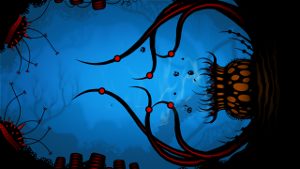Insanely Twisted Shadow Planet
(XBLA)

Insanely Twisted Shadow Planet wants you to feel small. Isolated. Sometimes the camera pulls back to shrink the size of your ship onscreen, just to underscore how alone you are.
Looking at videos or stills, you may think the environments are hostile. Pointy things are shorthand for dangerous environments. But here that’s not the case — tree branches and stalactites don’t kill you, they just get in the way. Curled silhouettes like that bridge in The Nightmare Before Christmas will unfurl when your ship’s weapon hooks them.
It happens a lot, because the ship has inertia. It takes a bit to start moving, and a bit to stop or turn. Use the momentum to throw the rocks you pick up using your claw arm upgrade, or to fling enemies into one another.
Because, like those pointy things that aren’t actually dangerous, this isn’t actually a twin-stick shooter. It’s a Metroid game where the suit you upgrade isn’t shaped like you, but is an upside-down bowl with a dangling central appendage. Missiles and lasers and guns.

The physics puzzles that involve grabbing things with the claw and throwing them, or positioning them in specific ways to bounce lasers, can get a little bit frustrating. Occasionally you’ll have to guide a missile through narrow, twisting passages to hit a target and open a door. You can control its direction, but not its throttle. A few too many collisions with the sides of the passage and it explodes and you have to launch another.
But that frustration is balanced by the feeling of newness that these activities have. It’s here that the game’s riffs on the Super Metroid template help it feel fresher than other games in the style.
The titular planet’s origin is revealed in cinematics that are unlocked by collecting artifacts hidden around the environments. It is actually some kind of invading alien lifeform that surrounds your sun and is phenomenally animated. The silhouette aesthetic can cause some of the areas to blend together a little too much, rather than underscoring their differences. Each has its own them (Organic, Mechanical, Electrical, among others), because, again, it’s Super Metroid.
The design gives it a continuity with the work of illustrator and artist Michel Gagne (Artistic Vision, Cinematics, Concept Art, Animation). The silhouettes and tentacles and teeth, the stretchiness of everything.
Like the Metroid games, it uses the absence of non-hostiles and sparse, atmospheric music to isolating effect. According to the credits, the music was composed by Norwegian metal band Dimmu Borgir and performed by the Prague Philharmonic. It never quite feels triumphant. Or positive.
Backtracking is not required. Rather than guiding you through areas more quickly as you progress, the upgrades are primarily used to open up small areas containing upgrades in previous areas. The best Metroidvania games constantly shuttle you back and forth as a way for you to learn the environment and to show you how you’ve progressed as those traversals become easier for you.
